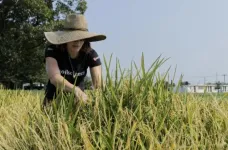(Press-News.org) Near the Florida-Georgia border, the Chattahoochee and Flint rivers meet and become the Apalachicola River, which carries freshwater and nutrients downstream to the Apalachicola Bay.
New research led by FAMU-FSU College of Engineering Assistant Professor Ebrahim Ahmadisharaf examined how drought and water volume in the Lower Apalachicola River watershed affect nitrogen and phosphorous, crucial nutrients for a healthy aquatic ecosystem. The study was published in Water Research.
“In watershed systems like this, that are subject to regulations upstream, knowing how the ecosystem reacts to changes helps us manage it effectively,” said Ahmadisharaf, who is also a researcher at the Resilient Infrastructure & Disaster Response Center, or RIDER. “We can regulate the system to avoid negative consequences, including some that have the potential to be long-lasting.”
The research team examined 20 years of nutrient data collected by the Apalachicola National Estuarine Research Reserve, a nationally protected natural organization funded by the National Oceanographic and Atmospheric Administration and managed by the Florida Department of Environmental Protection.
The researchers also analyzed streamflow data from a U.S. Geological Survey gauge to characterize drought and river flow conditions, which they compared to records of nutrients in the water using statistical analyses. That allowed them to investigate the impact of droughts and river flow patterns on nutrients in different phases of droughts and in short- and long-term periods after droughts ended.
Phosphorous levels
One of the nutrients researchers examined was dissolved inorganic phosphorus. When droughts first begin, phosphorus levels tend to increase slightly, and the range of these levels usually narrows. As droughts continue and get worse, the variability in phosphorus levels increases and the average level goes down. After droughts, when water flow increased, phosphorus levels in streams bounced back quickly because of the “flushing” effect, in which nutrients washed into the streams from the land. Three back-to-back streamflow droughts within the 20 years posed long-term consequences for the export of phosphorus. For example, phosphorus level increased in high flows by 35% from 2003 to 2021, which threatened the downstream estuary with excessive nutrient levels, increased microorganism growth and lower levels of dissolved oxygen.
Nitrogen levels
Researchers also examined changes in dissolved inorganic nitrogen. The impact of drought on nitrogen levels varied more, with the changes more linked to the severity of the drought, and its timing in wet or dry seasons. Nitrogen levels bounced back after droughts finished, but their dynamics within the stream flow patterns changed. For example, nitrogen levels in low flows became higher than those in high flows. Before and during droughts, researchers saw the opposite pattern.
In an ecosystem, as in medicine, the right dose makes all the difference. Nitrogen and phosphorous are essential nutrients for the growth of plants and animals. But too much of those nutrients causes problems such as harmful algae blooms, which deplete dissolved oxygen and produce toxins.
The rapid increase in phosphorous after droughts could lead to a temporary excess in the downstream ecosystem that would cause algae blooms, fish kills, and lead to problems with human health, Ahmadisharaf said.
Their findings give researchers a more detailed understanding of the Apalachicola River and its watershed. The impacts of drought can be specific to a place, so examining the river in detail is key.
“These findings give us a better understanding of how to manage nutrient levels carefully, especially during and after droughts, to avoid ecological problems,” Ahmadisharaf said. “Because climate change affects timing, severity and duration of droughts, this study is important for addressing climate resilience from the coastal water quality perspective.”
Sumon Hossain Rabby and Leila Rahimi, researchers at the RIDER Center, were the first and second authors of this study; the other co-authors were Ming Ye, a professor in the Florida State University Department of Scientific Computing; Jason A. Garwood, a researcher with the U.S. Department of the Interior; Ethan S. Bourque, a researcher with the Apalachicola National Estuarine Research Reserve; and Hamid Moradkhani, the Alton N. Scott Professor of Engineering at the University of Alabama.
This research was supported by the Florida Department of Environmental Protection and the National Oceanic and Atmospheric Administration.
END
FAMU-FSU College of Engineering researchers examine how drought and water volume affect nutrients in Apalachicola River
2024-09-06
ELSE PRESS RELEASES FROM THIS DATE:
Making baby food safer
2024-09-06
Rice and spinach are staples for babies’ and young children’s diets, but toxic metals and metalloids found in those foods can cause severe health impacts.
In particular, heavy metals such as cadmium, lead, mercury, and metalloid arsenic could delay brain development in babies and young children.
In new research published in the academic journal Environmental Geochemistry and Health, University of Delaware scientists have found that flooded rice fields tend to contain higher amounts of arsenic and lower amounts of cadmium. The drier those rice fields are, the lower the amounts of arsenic and the higher the amounts of cadmium. However, the higher cadmium is lower ...
Saline nasal drops reduce the duration of the common cold in young children by two days
2024-09-06
Using hypertonic saline nasal drops can reduce the length of the common cold in children by two days, according to a study that will be presented at the European Respiratory Society (ERS) Congress in Vienna, Austria [1]. They can also reduce the onward transmission of colds to family members.
The results of the ELVIS-Kids randomised controlled trial were presented by Professor Steve Cunningham from Child Life and Health, University of Edinburgh, UK.
He said: “Children have up to 10 to 12 upper respiratory tract infections, what we refer to as colds, per year, which ...
New RSV vaccine for older adults can result in individual and societal cost savings, benefits
2024-09-05
Vaccination against respiratory syncytial virus for adults over 60 is likely cost-effective by preventing illness, hospitalizations, lost quality of life and deaths, according to new research.
The study conducted by researchers at the University of Michigan and the U.S. Centers for Disease Control and Prevention and published in the journal Vaccine, evaluated newly approved RSV vaccines: Arexvy, manufactured by GSK, and Abrysvo, manufactured by Pfizer. The study did not include a third approved vaccine, Moderna's mRESVIA.
The vaccines are now available to adults 60 and older. The CDC recommends a single ...
Research news from the Ecological Society of America
2024-09-05
The Ecological Society of America (ESA) presents a roundup of seven research articles recently published across its esteemed journals. Widely recognized for fostering innovation and advancing ecological knowledge, ESA’s journals consistently feature illuminating and impactful studies. This compilation of papers explores the impact of rising temperatures on pathogens, dynamics of predatory seabirds and their penguin prey in Antarctica, factors determining the speed of coral reef recovery from disturbance and more.
From Ecology:
Some pathogens can’t ...
AI unlocks new path to personalized cancer treatments
2024-09-05
Researchers at Auburn University, in collaboration with scientists from the University of Basel and ETH Zurich, have made a groundbreaking advance in the fight against cancer. The team, led by Dr. Rafael Bernardi, Associate Professor of Biophysics in the Department of Physics, has developed a novel approach integrating artificial intelligence (AI) with molecular dynamics simulations and network analysis to enhance the prediction of binding sites on the PD-L1 protein. This breakthrough promises to accelerate the development ...
ResearchGate and Mary Ann Liebert, Inc. announce journal home partnership for open access journals
2024-09-05
ResearchGate, the professional network for researchers, and Mary Ann Liebert, Inc., a global media company dedicated to creating, curating, and delivering impactful peer-reviewed research and authoritative content services, are pleased to announce a new partnership through ResearchGate’s innovative Journal Home offering.
The partnership covers five Mary Ann Liebert, Inc. open access journals spanning the health and medical sciences. All backfile content and all new articles published with ...
Center for BrainHealth investigates the relationship between cannabis use, sleep and memory
2024-09-05
Dallas, September 5, 2024 – The growing legal use of recreational and medical cannabis has generated an increased concern for potential side effects from long-term use, particularly regarding problems with memory and sleep. Until now, the effect of cannabis use on sleep and on memory have only been studied separately. Research led by Francesca Filbey, PhD, from the Laboratory of Neuroimaging of Reward Dynamics at The University of Texas at Dallas’ Center for BrainHealth®, in collaboration with a team from the University of Amsterdam, aimed to fill this gap by testing how sleep impacts memory among cannabis users.
The study, “The ...
K-State researchers determine molecular interactions in plants
2024-09-05
Plant scientists have long known that phosphorus is a crucial component in plant growth. A major discovery by a K-State biologist and her lab is leading to a better understanding of how plants detect and use that resource — potentially leading to more efficient production of crops for food, fiber and fuel.
A team of researchers led by Kathrin Schrick, associate professor of biology, recently published this research in New Phytologist, a high-impact journal in the plant sciences.
Schrick's lab focused on a specific transcription factor that regulates gene expression during development. They discovered a new kind of molecular interaction between the ...
Study estimates home blood pressure devices don’t fit properly for more than 17 million US adults
2024-09-05
Over-the-counter blood pressure measuring devices offer a simple, affordable way for people to track hypertension at home, but the standard arm-size ranges for these devices won’t appropriately fit millions of U.S. consumers, according to a new study from researchers at the Johns Hopkins Bloomberg School of Public Health.
The researchers compared standard arm cuff size ranges for popular retail automatic blood pressure measuring devices to arm circumference data from U.S. government-sponsored national ...
Brain scans reveal that mindfulness meditation for pain is not a placebo
2024-09-05
Pain is a complex, multifaceted experience shaped by various factors beyond physical sensation, such as a person’s mindset and their expectations of pain. The placebo effect, the tendency for a person’s symptoms to improve in response to inactive treatment, is a well-known example of how expectations can significantly alter a person’s experience. Mindfulness meditation, which has been used for pain management in various cultures for centuries, has long been thought to work by activating the placebo response. However, scientists have now ...







